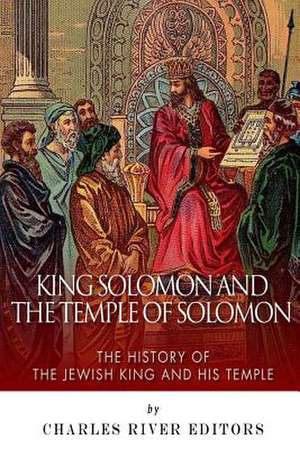King Solomon and Temple of Solomon
Autor Charles River Editorsen Limba Engleză Paperback
*Discusses the debate and theories over the historical and religious nature of King Solomon's life, and the construction and operation of the temple
*Compares the Bible to the historical record to trace the roots of Solomon's reign and temple
*Includes a bibliography for further reading
King Solomon is one of the most famous men in the Bible, but also one of the most elusive historical figures. He is credited with supervising the construction of the first Temple in Jerusalem, and excavations and archaeologists continue to dig in an effort to find it in places that are now religiously sensitive for Christians, Jews, and Muslims.
Information about King Solomon comes almost exclusively from the book of Kings, occasionally supplemented by additional material found in the book of Chronicles. This is problematic for several reasons. First, the book of Kings does not simply record the actions of the king and the details of his reign for posterity; the author weaves a narrative that is often more concerned about making theological points rather than recording historical details. Moreover, the first edition of this book was written in the 6th century B.C. at the earliest, about four centuries after King Solomon would have lived, by an editor given the title of Deuteronomistic Historian. It is likely that this editor relied upon some type of royal "court history" as a source document.
The temptation with a figure like Solomon can be to go to one of two extremes. Some readers may want to look at Solomon only as a historical figure without acknowledging the literary elements that play a big role in his life story. Other readers may find themselves at the other extreme and view Solomon entirely as a literary figure, dismissing any historicity at all from his story. Given how important he is as a religious figure, it's necessary to keep in mind both the literary and historical elements of the monarch's story.
There was not any one entity more central to the Yahwistic Judean religion during the monarchy than the temple of Solomon. It symbolized the presence of YHWH in the nation, as well as his enduring protection of the nation and the Davidic royal throne. Judean worshippers directed their prayers toward the Solomonic temple, and eventually, the Judean prophets and theologians declared that this was the only legitimate location where priests could perform sacrifices and other religious rites for YHWH. Its significance can be seen most clearly in the dramatic cognitive dissonance experienced by the Judeans in Babylonian captivity after the destruction of the temple, which had been so central to their religious conception that they had great difficulty reconciling its destruction with their continued belief in YHWH at all.
The Temple and the Biblical descriptions of it have fascinated people for centuries and led to all kinds of conjecture and imagination. In addition to countless works of art, Isaac Newton tried to make a model of it in his writings, and he wrote about the temple extensively. Even Freemasons give a nod to Solomon's Temple by calling their meeting places temples as well. That said, the Temple remains an enduring mystery due to conflicting accounts and descriptions of it in the Bible, and some scholars have even put forth theories that the structure was not originally designed to serve religious purposes in the first place.
King Solomon and Temple of Solomon: The History of the Jewish King and His Temple discusses the history, mystery and controversy surrounding Solomon and the temple, examining the Bible and historical record in an attempt to separate fact from fiction. Along with pictures and a bibliography, you will learn about Solomon and Solomon's Temple like never before.
Preț: 65.68 lei
Nou
12.57€ • 13.12$ • 10.40£
Carte disponibilă
Livrare economică 14-28 martie
Specificații
ISBN-10: 1500140732
Pagini: 72
Dimensiuni: 152 x 229 x 4 mm
Greutate: 0.11 kg
Editura: CREATESPACE
